What's Happening?
The Metropolitan Museum of Art has returned a late-18th century Buddhist painting, The Tenth King of Hell, to Korea. This repatriation is part of the museum's Cultural Property Initiative, which aims to return cultural
artifacts to their countries of origin. The painting was taken during the Korean War when the United States Army controlled the Sinheungsa Temple in Sokcho, Gangwon Province. The artwork is part of a series depicting the Ten Kings of the Underworld, with three pieces still abroad. The return was celebrated in Seoul, attended by various cultural and governmental leaders, including Max Hollein, Director and CEO of the Met, and Heo Min, Administrator of Korea Heritage Service.
Why It's Important?
The return of The Tenth King of Hell to Korea underscores the growing global momentum for repatriating cultural heritage. This initiative reflects a broader effort to address historical injustices and restore cultural artifacts to their rightful places. The Met's actions highlight the importance of collaboration between public and private sectors in achieving meaningful cultural restitution. Such efforts can strengthen international relations and promote cultural understanding. The return of this painting is a significant step in acknowledging and rectifying past transgressions, fostering goodwill between nations, and preserving cultural heritage.
What's Next?
The Sokcho Committee for the Return of Cultural Heritage in Korea hopes to eventually reunite the entire series of paintings at the Sinheungsa Temple. Continued efforts in cultural restitution may lead to further collaborations between museums and countries to return artifacts. The Met's Cultural Property Initiative is likely to continue its work, potentially influencing other institutions to follow suit. This could result in more artifacts being returned to their countries of origin, promoting cultural preservation and international cooperation.
Beyond the Headlines
The repatriation of cultural artifacts like The Tenth King of Hell raises important ethical questions about ownership and the legacy of colonialism and war. It challenges museums and collectors to reconsider the provenance of their collections and the moral implications of holding onto cultural heritage that belongs elsewhere. This movement towards restitution may also inspire broader discussions on cultural identity and the importance of preserving heritage in its original context.












